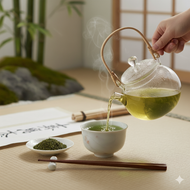The Art of Sencha: A Guide to Japan's Most Popular Green Tea
Posted by Reese Colbert on 13th Oct 2025
The Art of Sencha: A Guide to Japan's Most Popular Green Tea
When you think of Japanese tea, one image likely comes to mind: a vibrant, emerald-green infusion that is both refreshing and deeply satisfying. That tea is almost certainly Sencha. Accounting for nearly 80% of all tea produced in Japan, Sencha is the quintessential daily drink, a symbol of Japanese hospitality and the heart of its tea culture.
But what makes this particular green tea so special? Its magic lies in a unique processing method and a brewing technique that is an art form in itself. Today, we're exploring the bright, grassy world of Organic Green Tea Sencha, unlocking the secrets to its flavour, and guiding you on how to brew the perfect cup, free of bitterness.
Steamed to Perfection: The Secret to Sencha's Flavour
All tea comes from the same plant, Camellia sinensis. The vast differences in flavour between green, black, and oolong teas come from how the leaves are processed after they are picked, specifically concerning oxidation. To make green tea, oxidation must be stopped as quickly as possible.
This is where Japanese Sencha diverges from most Chinese green teas. Chinese teas are typically pan-fired or roasted in a hot wok to halt oxidation. This process imparts a warmer, toastier, and sometimes nutty flavour to the leaves.
Japanese producers, however, use steam. Immediately after harvesting, the Sencha leaves are briefly steamed at a high temperature. This method locks in the vibrant, deep green colour of the fresh leaves and preserves their fresh, vegetal character. This steaming process is responsible for Sencha's signature flavour profile:
- Grassy and Vegetal: A fresh, clean taste reminiscent of steamed spring greens.
- Umami: A pleasant, savoury, and slightly oceanic or brothy note that adds depth and complexity.
- A Sweet Finish: A delicate, lingering sweetness that balances the other flavours.
The Art of Brewing: Your Guide to a Bitter-Free Cup
Many people who think they dislike green tea have simply been drinking it brewed incorrectly. Green tea, and Sencha in particular, is very sensitive. Using the right technique is the difference between a sweet, sublime experience and a bitter, astringent disappointment. There are three golden rules.
1. Lower Your Water Temperature (The #1 Rule)
This is the most critical step. Never use boiling water on Sencha. Boiling water scorches the delicate leaves, causing them to release an excess of tannins and catechins, which are the compounds responsible for bitterness.
- The Sweet Spot: The ideal temperature is between 75°C and 85°C. If you don't have a temperature-controlled kettle, simply boil the water and let it sit for 2-3 minutes before pouring.
2. Measure Your Leaves
A good starting point is one heaped teaspoon of Sencha leaves per 200-250ml cup. You can adjust this based on how strong you like your tea.
3. Watch Your Steeping Time
Sencha infuses quickly. Over-steeping is the second most common cause of bitterness.
- First Infusion: Aim for just 1 to 2 minutes. This initial steep will be the most delicate and aromatic, with the strongest umami notes.
The Joy of Multiple Infusions
One of the great pleasures of a quality loose-leaf tea like Sencha is that the leaves can, and should, be steeped multiple times. Each infusion will offer a slightly different flavour profile as the leaves unfurl.
- Second Infusion: Use slightly hotter water and a much shorter steep time—often just 30-45 seconds. This infusion is typically bolder and more robust, with less umami and more pronounced grassy notes.
- Third Infusion: Use hotter water again, and steep for around 1-2 minutes. The flavour will be softer and milder, a gentle end to the tea session.
Experimenting with these subsequent infusions is a wonderful way to appreciate the full character of the tea.
Sencha vs. Matcha
While both are famous Japanese green teas, they are fundamentally different. Sencha is an infusion—you are drinking the liquid that the steeped leaves have flavoured. Matcha is a suspension—you are consuming the entire tea leaf, which has been stone-ground into a superfine powder and whisked into the water. This is why Matcha has a much higher concentration of caffeine and nutrients.
A Moment of Refreshing Clarity
Brewing a cup of Organic Green Tea Sencha is more than just making a drink; it's a mindful practice. It asks for a moment of attention to the details—the temperature, the time, the aroma. The reward is a beverage that is vibrant, refreshing, and deeply satisfying. It's the perfect daily ritual to bring a moment of clarity and deliciousness to your day.

